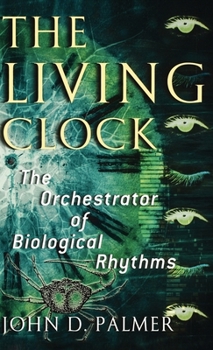The Living Clock: The Orchestrator of Biological Rhythms
From one-celled paramecium to giant blue whales, we all have internal clocks that regulate the rhythms we live by. In The Living Clock, John Palmer, one of the world's leading authorities on these rhythms, takes us on a tour of this broad and multifaceted subject, examining everything from glowing fruit flies to the best cures for jet lag.
Palmer has a wonderful sense of humor and an eye for the startling fact. We learn that fiddler crabs--in a lab where there are no time nor tide cues--remain active when low tide would occur and motionless during high tide, the same pattern they follow in their natural habitat. (In fact, you can remove a crab's leg and the leg will keep a tidal rhythm as long as it's kept alive.) Moreover, humans are subject to more than one hundred biological rhythms. Mental acuity peaks in the afternoon, for instance, and our blood pressure peaks at seven in the morning (when most heart attacks occur). The time of day you take medication can affect how well it works. And Palmer shows that when our clocks are thrown off kilter, trouble follows, especially for rotating shift workers--the Bhopal spill, the Chernobyl reactor explosion, and the Three Mile Island accident all happened when new crews began early-hour shifts.
No one has discovered exactly how our internal clocks work--Palmer says a Nobel Prize awaits that lucky scientist--but they are no less fascinating for their inexplicable nature. Frequently amusing and always eye-opening, The Living Clock is a treat for everyone curious about the nature of life as well as anyone planning a long jet flight.
Palmer has a wonderful sense of humor and an eye for the startling fact. We learn that fiddler crabs--in a lab where there are no time nor tide cues--remain active when low tide would occur and motionless during high tide, the same pattern they follow in their natural habitat. (In fact, you can remove a crab's leg and the leg will keep a tidal rhythm as long as it's kept alive.) Moreover, humans are subject to more than one hundred biological rhythms. Mental acuity peaks in the afternoon, for instance, and our blood pressure peaks at seven in the morning (when most heart attacks occur). The time of day you take medication can affect how well it works. And Palmer shows that when our clocks are thrown off kilter, trouble follows, especially for rotating shift workers--the Bhopal spill, the Chernobyl reactor explosion, and the Three Mile Island accident all happened when new crews began early-hour shifts.
No one has discovered exactly how our internal clocks work--Palmer says a Nobel Prize awaits that lucky scientist--but they are no less fascinating for their inexplicable nature. Frequently amusing and always eye-opening, The Living Clock is a treat for everyone curious about the nature of life as well as anyone planning a long jet flight.
Format:Hardcover
Language:English
ISBN:019514340X
ISBN13:9780195143409
Release Date:March 2002
Publisher:Oxford University Press
Length:176 Pages
Weight:0.85 lbs.
Dimensions:0.8" x 6.9" x 8.4"
Customer Reviews
1 rating
Fairly entertaining book about scientific discovery.
Published by Thriftbooks.com User , 21 years ago
Palmer explains that he wrote this book because so many people he encountered were interested in what he does as a marine biologist. In truth it is a book about scientific curiosity and the process of discovery. I won't give away the ending, found in the last chapter. Had Palmer's objective been an exposition on biological clocks, the last chapter would have been first. Unfortunately, I already knew what was in the last chapter, so my appreciation for the book was somewhat dulled. Still, it is a short, well written, fairly entertaining book. Palmer does an excellent job in describing experiments and making them interesting, and in showing how often a verification of the obvious led instead to new paths of discovery. Not least, while Palmer's sense of humor is not terribly creative, he can be fun.






